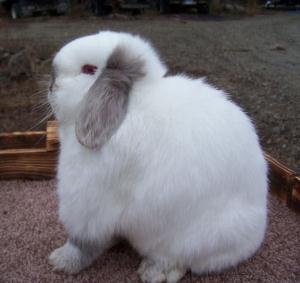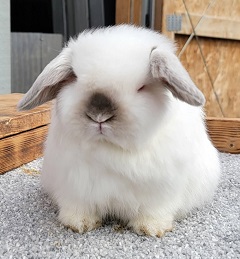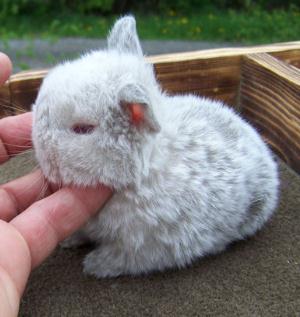Pictures of Holland Lops in the Pointed White Group: Black, Blue, Chocolate and Lilac
Pointed Whites. Broken colors are not shown as they are NOT showable (no color on the feet).
Optimally, you would want two Himalayan alleles (termed 'homozygous') "c(h)c(h)" and two full-extension alleles "EE" when breeding for
Pointed Whites (PWs). Pointed Whites with a single Himalayan allele (heterozygous) tend to have smaller and paler points then homozygous c(h). Also, non-extension PWs, 'ee',
have paler points then the optimal full-extension, E_. PWs that are "c(h)c" and "ee" tend to have very light points.
Pointed Whites and REW are the ONLY two colors that have a ruby eye.
With the popularily of the BEW (Blue-Eyed White) currently, note that a rabbit that is ccvv (REW + BEW) or c(h)_vv (PW + BEW) will appear REW. The 'vv' of the BEW removes all the
body color, leaving the blue eye. The REW and Himalayan genes will further remove all color from the eye, leaving a rabbit that looks like a REW, but is also genetically a BEW.
| Few Days Old | Few Weeks Old | Adult Color |
| "The body color is to be white to the skin, except the points. The colored points are
the nose, ears, feet, legs, and the tail. The color of the points is to be as described in the respective
self varieties and the color is to be deep and even. The nose marking is to come well up on the face
and be well rounded, clean cut, and distinct. The markings are to be carried well up the forelegs
and above the hock joint on the hind legs. The ears are to be well colored and clean at the base.
Allowances should be made for developing color on juniors. The upper and lower sides of the tail are to
be well colored. Toe nails are to be colored. The eyes are to have a ruby red pupil, with a lighter pink
color in the iris." |
| Black Pointed White, aa_B_c(h)_D_E_ |

Typically, you can not tell a Pointed White kit from a REW. At about 7 days of age or so, the points will start to darken
on the PW kits. Color usually comes in on the tail first.
In this photo, the top 2 kits are Pointed Whites (one REW in the litter for comparison) showing what is called "nest box frost" or "winter smut".
Pointed Whites born in cold weather sometimes get enough of a chill that their baby fur grows in frosted. The himi gene is temperature-sensitive,
and points grow in darker when its cold, and even the body color on adults can get some smut if its cold enough.
When the frosted PW kits grow an adult coat, their bodies will return to clean white. Picture permission of Laura Lyon. |


Three-week old litter: 4 REWs and 2 Pointed White kits. Tail color usually manifests itself first. Pictures permission of Laura Lyon. |

Pix generously provided with permission from Bradley Clapp of Eight Points Rabbitry.
|
| Chocolate Pointed White, aa_bbc(h)_D_E_ |

This kit was chilled in the nestbox, allowing it's broken pattern to be 'exposed'. This will molt out
and the kit will look like a typical broken PW (white feet is the best indicator).
Pix generously provided with permission from Bradley Clapp of Eight Points Rabbitry.
|
Need pix. |

Pix generously provided with permission from Bradley Clapp of Eight Points Rabbitry.
|
| Blue Pointed White, aa_B_c(h)_ddE_ |
| Need pix. |
Need pix. |

Country Fl~Hare's Dotty, pictures permission of Laura Lyon.

Pix generously provided with permission from Bradley Clapp of Eight Points Rabbitry.

Pix generously provided with permission from Bradley Clapp of Eight Points Rabbitry.
|
| Lilac Pointed White, aa_bbc(h)_ddE_ |
| Need pix. |
Need pix. |

Broken Lilac PW - note the white feet. Known to be aabbc(h)cddE-. Pix generously provided with permission from Bradley Clapp of Eight Points Rabbitry.

Broken Lilac PW - note the white feet. Known to be aabbc(h)cddE-. Pix generously provided with permission from Bradley Clapp of Eight Points Rabbitry.
|
The Himalayan (himi for short) gene is temperature sensitive. These are pictures of a REALLY nestbox-frosted Blue Pointed White doe.
Photo's and comments from Laura Lyons.


Two-weeks old, right about when her eyes opened -- up until that point I thought she was a Blue Point (Dilute Sable Point.)

At six-weeks old.

At eight-weeks old. You can see the pure white coming in under the frosted baby coat,
and around her eyes and muzzle she has lost some of the frosted baby coat in a molt pattern.

















